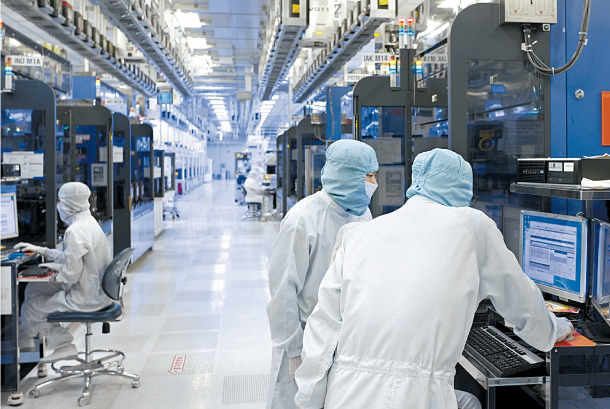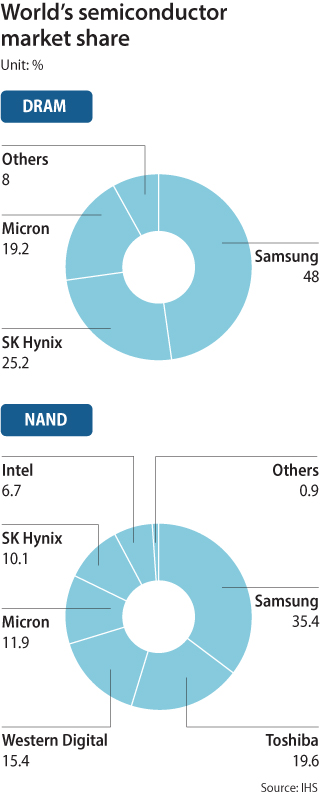Samsung and SK Hynix suffer semiconductor talent shortage

Employees monitor the production of 300-millimeter wafers at SK Hynix’s factory in Icheon, Gyeonggi. [SK HYNIX]
“The workload has been piling up to the point where we’re struggling to meet orders,” said a Samsung Electronics official. “And as we’re also increasing our lineup, we’re very short on workers with expertise.”
Samsung Electronics and SK Hynix are looking to hire experienced workers, but also high school graduates. On the company’s recruitment website, Samsung Electronics recently posted a hiring notice for experienced workers to join the company’s memory chip businesses at its device solution department.
The hiring posts included opportunities in memory chip production, marketing, software and device processing.

In the first half of this year, Samsung hired 300 graduates of vocational high schools.
In the past, the company hired students for its production posts, but since August of last year, a revised bill bans students from working overtime or on holidays, and the semiconductor production plant has to run 24 hours without stopping.
As a result, teachers at vocational high schools were calling up old students to tell them that Samsung is hiring.
Earlier this month, SK Hynix started hiring experienced workers for its SSD department, seeking candidates with a bachelor’s degree in electronics or computer software and eight years of experience for its quality-evaluation posts.
Additionally, the company is hiring experienced workers for DRAM testing solution software developer and memory system architecture designer.
Both companies have seen better-than-expected performance, largely thanks to increasing demand in the global market, a result of the development of technologies such as virtual reality, the Internet of Things and big data services.
In the second quarter, Samsung Electronics’s semiconductor operating profit reached a new record at 8 trillion won ($6.98 billion), a 73 percent year-on-year increase and more than half the 14 trillion won the company made in its overall operating profits.
SK Hynix also saw its operating profit reach an all-time record at 3.6 trillion won, a 573.7 percent year-on-year increase. But more noticeable was the fact that its operating profit-to-sales ratio was 45.6 percent, higher than other global competitors.
And the outlook for the semiconductor business overall is favorable. Last month, Gartner projected that the global semiconductor business will likely expand 16.8 percent compared to last year, surpassing $400 billion for the first time.
“A shortage of memory is creating a boom in the overall semiconductor market,” said Andrew Norwood, Gartner’s research vice president. “Memory vendors have been able to increase their price for DRAM and NAND, driving revenue and margins higher.”
Norwood added that Samsung Electronics will likely stand to gain the most, as the world’s largest memory supplier.
According to IHS Markit, as of end of last year, Samsung Electronics and SK Hynix dominate the global DRAM business. Samsung Electronics holds a 48 percent market share while SK Hynix takes up one-quarter of the market share.
Even in the NAND chip business, Samsung takes up more than one-third of the global market share. SK Hynix, which only has a 10 percent market share in NAND chips, is hoping to expand its influence by buying Toshiba, which is second to Samsung with 19.6 percent.
The market is already projecting that Samsung and SK Hynix will likely post a similar or even better performance in the third quarter.
“[Samsung’s] semiconductor business is likely to reach a new record in operating profit at 9.4 trillion won [in the third quarter],” said Euh Kyu-jin, an analyst at eBest Investment Securities.
Semiconductor production jobs are usually divided into three categories: production, engineering and research. In the past, production employees personally handled the wafers themselves, but these days, production has become automated.
Engineers maintain and repair production equipment. Both production and engineering workers typically have high school diplomas.
But researchers, who design the semiconductors, are in short supply.
While the number of employees with a bachelor’s degree is greater than the number of employees with higher degrees, recently the number of employees with either a masters or doctorate degree has been increasing.
While both Samsung and SK Hynix prefer researchers who can jump right in, such quality employees are hard to come by.
The company’s vice chairman, Kwon Oh-hyun, who recently met with President Moon Jae-in, said the semiconductor business is facing a serious problem it terms of sourcing quality talent.
“Semiconductors are a hard business and because of that, there aren’t many college students who specialize in this field,” said Lee Seung-baek, Samsung Electronics semiconductor managing director. “It’s not easy to find talent overseas, either, because Korea’s technology excels in this field.”
The shortage of workers is likely to continue for the time being.
Samsung Electronics is planning to spend 20 trillion won this year in expanding its semiconductor production line, especially its 3D NANDD production, while SK Hynix is planning to spend 9.6 trillion won on expanding its computer chip production.
BY PARK TAE-HEE, LEE HO-JEONG [lee.hojeong@joongang.co.kr]










with the Korea JoongAng Daily
To write comments, please log in to one of the accounts.
Standards Board Policy (0/250자)